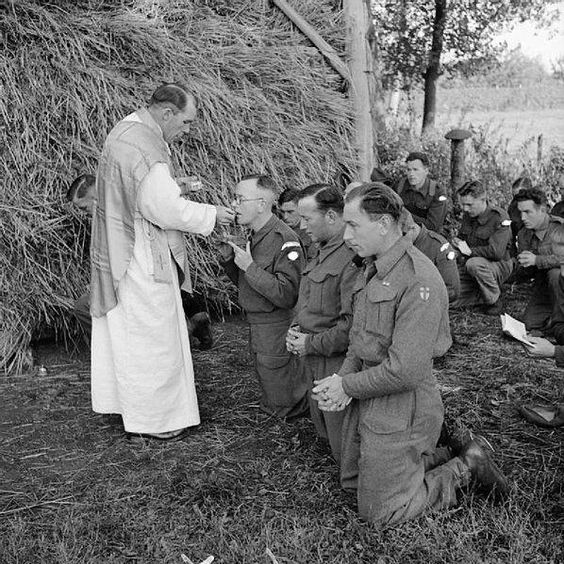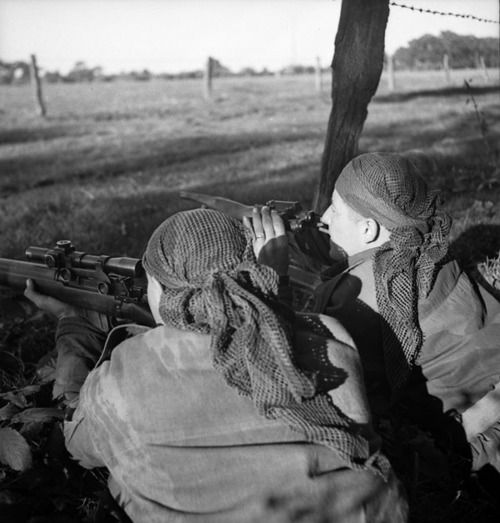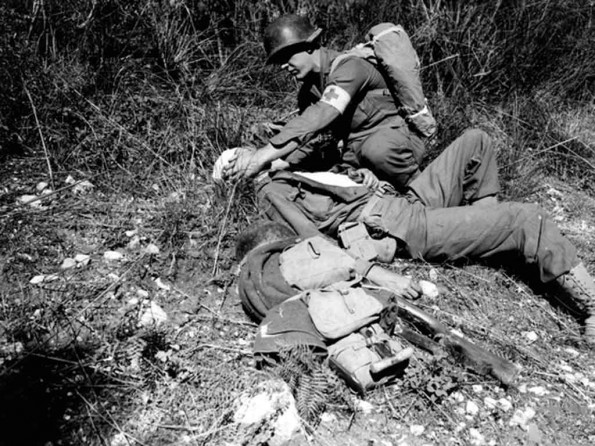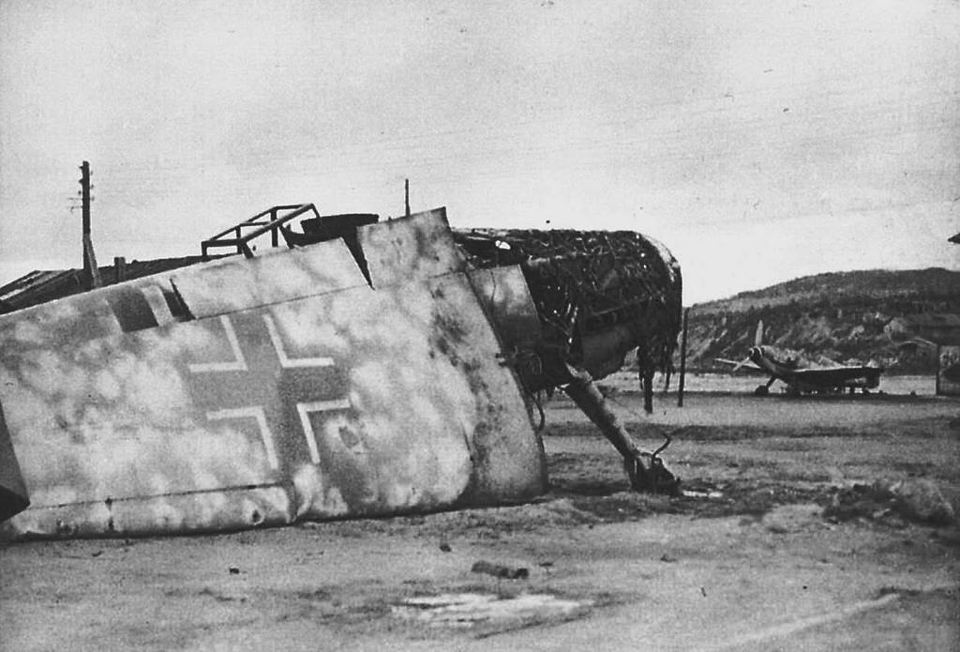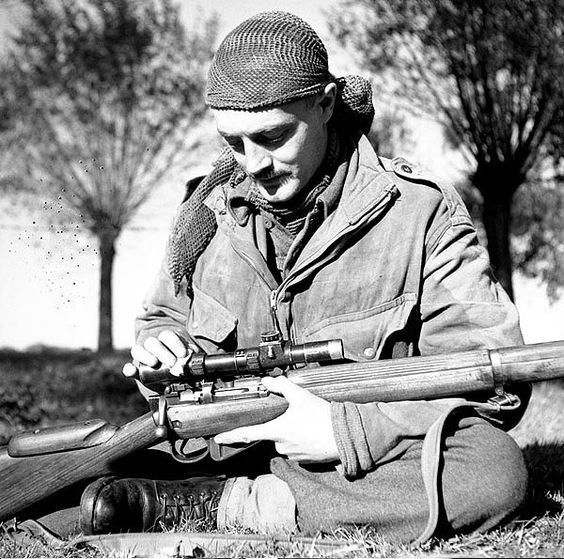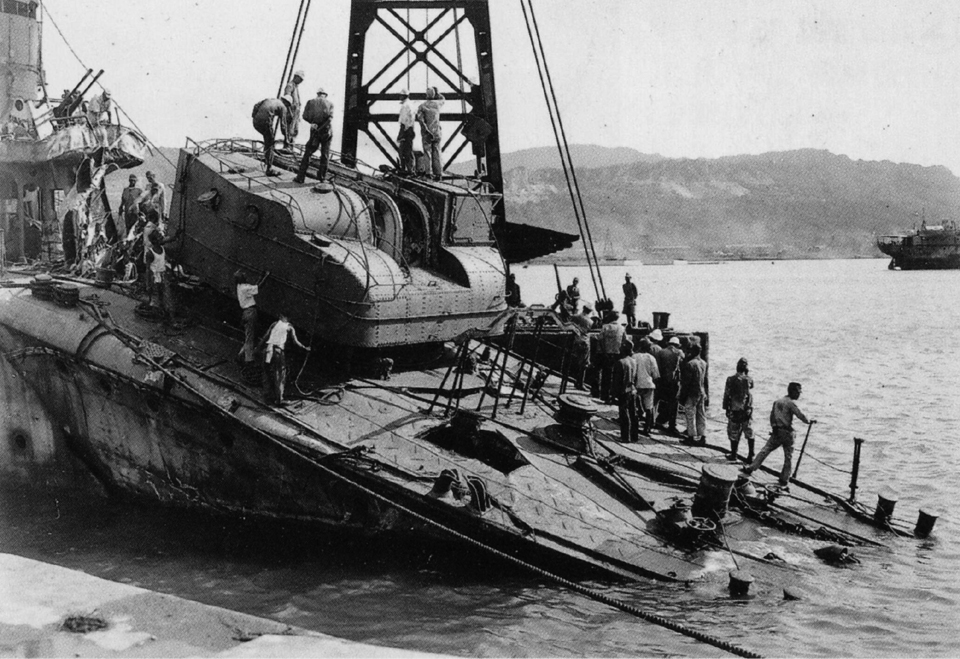Air Operations, CBI
BURMA- 8 10th Air Force B-25s attack bridges at Hsenwi.
- More than 20 10th Air Force P-47s attack a bridge at Seywa and Japanese Army ground troops at Bilumyo and Mawlu.
- 12 341st Medium Bomb Group B-25s attack Wuchou and targets of opportunity around Canton.
- More than 50 14th Air Force fighter-bombers attack targets of opportunity south of the Yangtze River.
Air Operations, East Indies
- FEAF B-25s and P-38s attack Amahai on Ceram, Namlea on Boeroe, and Waai on Celebes.
- P-38s attack the Kaoe airfield on Halmahera and shipping near Djailolo Island.
Air Operations, Europe
RAF BOMBER COMMANDDaylight Ops:
- 254 Halifaxes of No. 4 Group and 46 Lancasters and 20 Mosquitos of No. 8 Group attack the synthetic oil plants at Sterkrade and Scholven/Buer. Both raids take place in clear conditions and the bombing is considered to be accurate.
- 4 Halifaxes and 2 Lancasters are lost on the Scholven raid and 3 Halifaxes on the Sterkrade one.
- 4 Liberators and 3 Wellingtons fly signals investigation patrols without a loss.
- 523 aircraft of Nos. 3, 6 and 8 Groups are sent to Dortmund. Included in the aircraft total are 248 Halifaxes, 247 Lancasters and 28 Mosquitos. No. 6 Groups provides 293 aircraft, the greatest effort by the Canadian group during the war. This raid opens a phase which some works refer to as 'The Second Battle of the Ruhr'. The Pathfinder marking and the bombing are both accurate and severe damage is caused, particularly to the industrial and transportation areas of the city, although residential areas also suffer badly.
- 2 Halifaxes, 2 Lancasters and 1 Mosquito are lost.
- 246 Lancasters and 7 Mosquitos of Nos. 1 and 5 Groups carry out the last of 32 major Bomber Command raids on Bremen during the war. The raid, based on the No 5 Group marking method, is an outstanding success. Severe damage is caused to the AG Weser shipyard, the two Focke-Wulf factories, the Siemens Schuckert electrical works and other important war industries. The 'transport network' is described as being seriously disrupted. It is interesting to note the increased efficiency and hence destructive power of Bomber Command at this time. Bremen, with its shipyards and aircraft factories, had been the target for many carefully planned Bomber Command raids earlier in the war and was the target for one of the much publicized 1942 1,000-bomber raids. Now this raid by no more than a quarter of the total strength of Bomber Command, hardly mentioned in the history books, has finished off Bremen and this city need not be attacked by Bomber Command again.
- 5 Lancasters are lost.
- 22 Mosquitos are sent to Berlin, 11 to Ludwigshafen and 2 to Saarbrücken, 19 aircraft lay mines off Texel and Heligoland and in the Weser River, 6 aircraft are on Resistance operations, and there are 76 Mosquito patrols and 35 RCM sorties.
- 1 Mosquito is lost on the Berlin raid and 1 on a Serrate patrol.
GERMANY:
- In the 8th Air Force's largest mission to date, exactly 1,200 effective heavy-bomber sorties are mounted as follows: 199 1st Bomb Division B-17s attack the Stargard Airdrome; 12 1st Bomb Division attach the city of Stettin; 73 1st Bomb Division B-17s attack an aircraft-industry factory at Neubrandenburg; 100 1st Bomb Division B-17s attack the city of Straslund; 38 1st Bomb Division B-17s attack several targets of opportunity; 289 2nd Bomb Division B-24s attack two oil-industry targets and a munitions dump at Hamburg; 46 2nd Bomb Division B-24s attack an aircraft-industry target at Wenzendorf; 41 2nd Bomb Division B-24s attack various targets of opportunity; 144 3rd Bomb Division B-17s attack a munitions dump at Berlin; 138 3rd Bomb Division B-17s attack an aircraft factory at Berlin; 100 3rd Bomb Division attack an armored-vehicle factory at Berlin; 10 3rd Bomb Division B-17s attack targets of opportunity.
- 19 heavy bombers and 4 of 699 VIII Fighter Command escort fighters are lost
- The 20th Fighter Group claims the destruction of 40 German seaplanes during strafing attacks against five seaplane bases between Stettin and Lubeck.
GERMANY:
- 9th Air Force fighter-bombers support the US 3rd and 7th Armies and attack rail lines around Dorsel.
- Altogether, in the first significant fighter actions of the month, 8th and 9th Air Force fighter pilots down 22 Luftwaffe fighters over Germany between 1100 and 1650 hours.
- More than 300 9th Bomb Division B-26s and A-20s attack an ammo dump, barracks, and marshalling yards at Duren and Hengelo, and bridges at Aldenhoven and Arnhem.
GREECE:
- 15th Air Force P-38 and P-51 fighters strafe the Athens/Eleusis, Athens/Kalamaki, Athens/Tatoi, Megalo Mikra, Megara, and Salonika/Sedhes Airdromes.
ITALY:
- The 12th and 15th Air Forces are again grounded by bad weather.
Air Operations, New Guinea
V Fighter Command P-47s attack Kaimana.
[Air Operations, Volcano Islands
During the night, 30th Heavy Bomb Group B-24s mount harrassment attacks against Iwo Jima.
[China
As a result of the breach between Chiang Kai-shek and Roosevelt, Gen Stilwell is relieved of the post of Chief of Staff to the Generalissimo. He is now only to command the Chinese troops in Burma and those, trained and equipped by the Americans, in the province of Yunnan. Stilwell is also relieved of his responsibility for supplies to China under the Lend-Lease Act.
[Eastern Front
Units of the Leningrad Front land on Saaremaa Island, south of Hiiumaa Island, in the Gulf of Riga. Russian forces cross into Czechoslovakia over the Tisca River from Hungary.
LITHUANIAThe 3rd Panzer Army is reeling as the Soviet 4th Shock, 5th Guards Tank, 6th Guards, 39th, 43rd and 51st Armies join the offensive and the weather allows the Soviet 1st Air Army to fly ground-support missions. Hitler forbids the abandoment of Riga.
HUNGARYThe Soviet Debrecen Offensive opens. The 2nd Ukrainian Front (Group Pliev, the 7th Guards, 6th Guards Tank, 27th, 40th, 46th and 53rd Armies) attacks between Oradea and Arad, smashing the Hungarian 3rd Army. In the northeast of the country, the Soviet 1st Guards and 18th Armies (4th Ukrainian Front) engage the 1st Panzer and Hungarian 1st Armies. Pancevo falls to the Soviet 46th Army.[MORE]
[Pacific
- The Japanese gunboat Saga is sunk by a mine off Hong Kong.
- The Japanese Coastal Defense Vessel No. 21 is sunk by the US submarine Seahorse (SS-304) in the South China Sea.
- U-168 is en route from Batavia to Surabay to join U-537 and U-862 in operations off the Australian coast when she is spotted by the Dutch submarine Zwaardvisch. The Dutch submarine fires 6 torpedoes at a range of 900 yards. One explosion is heard, and looking through the periscope, the commander sees the U-boat sinking by the bows.
- The US submarine Cabrilla (SS-288) damages the Japanese transport Hikurei Maru and sinks the tanker No.2 Yamamizu Maru (5154t) off the west coast of Luzon.
- The US submarine Whale (SS-239) sinks the Japanese transport Kinugasa Maru (8407t) and the merchant tanker Akane Maru (10,241t) west of Balintang Channel, north-northwest of Luzon.
- The British submarine Tally Ho sinks the Japanese auxiliary submarine chaser CHA-2 about 100 miles west of Penang, Malaya.
- The Japanese gunboat Saga is sunk by mine off Hong Kong.
| Class | Type IXC |
| CO | Kapitänleutnant Helmut Pich |
| Location | Java See, off Surabaya |
| Cause | Submarine attack |
| Casualties | 23 |
| Survivors | 27 |
Palau Islands
Operations on Peleliu come to a standstill again. On Angaur, artillery fire is resumed against the Japanese at the extreme northwest of the island.
[Western Front
The Canadian II Corps begins attacks to eliminate the German forces holding out south of the Scheldt between the Leopold Canal and the south bank of the river around Breskens. The ground conditions are very difficult with many wet and flooded areas. The extreme west of the Dutch mainland has already been evacuated by the Germans; there is just one division left, manning the small port of Breskens, south of Flushing. The attack makes a little progress. This attack is called the 'battle of the polders', fought in mud and water. North of the Leopold Canal they are able to set up 2 small bridgeheads. German reaction is extremely violent and forces the Canadians to send substantial reinforcement to the bridgeheads they have won.
The XIX Corps of the US 1st Army continues the battle around Aachen and at Geilenkirchen, on the Siegfried Line.
[Images from October 6, 1944
|
|
|
|
|
|
With an MTB Flotilla |
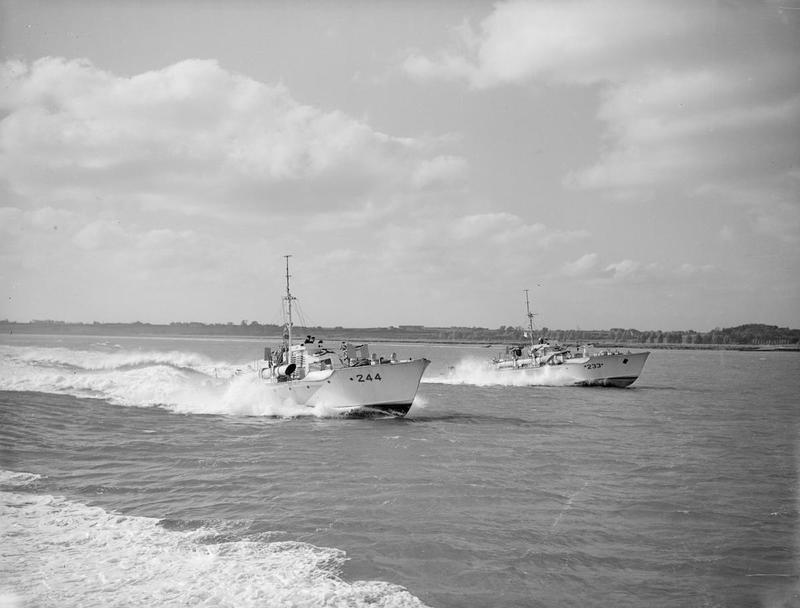 |
